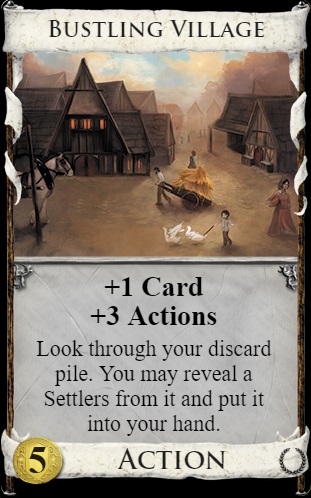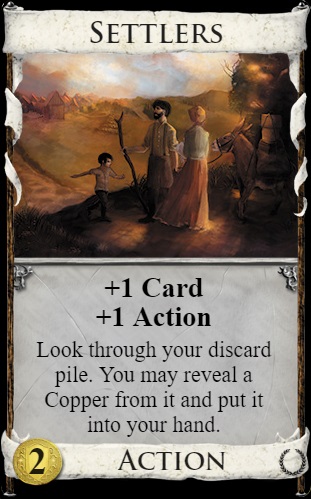1
Dominion Articles / Storyteller
« on: August 27, 2018, 01:40:11 pm »
Storyteller is a card unlike anything else in Dominion, being the only card to let you effectively spend your economy for massive amounts of non-terminal draw. In doing so, Storyteller both spends whatever virtual economy youíve built up so far (the card itself providing $1, making it a cantrip when played alone) while letting you play up to 3 of your treasures. While this effect seems counterproductive at first glance, +1 card is almost always preferable to $1 as long as you still have cards to draw. Provided your drawn card is better than a Copper, turning your economy into cards will almost result in a better turn overall.
Weaknesses and Basic Strategy
Storyteller is a card that, at worst, plays itself as a cantrip, while potentially being one of the strongest sources of non-terminal draw in the game. What weaknesses could the card even have? In a vacuum, not many. Provided youíve trashed your Coppers and Estates, 3 to 5 Storytellers and an ample supply of Silver or Gold can be the sole source of draw in a thin deck that consistently draws itself. Being able to consistently acquire 10-20+ card hands non-terminally is a major boon, allowing you to spend your terminal actions on attacks or powerful payload cards such as Bridge.
On weaker boards, itís a perfectly valid strategy to build a ĎStoryteller + Big Money + Xí deck, ĎXí being a particularly strong terminal and/or a +buy card to take advantage of the massive hands this deck can generate. While most Storyteller-BM-X strategies can easily beat traditional BM, against more traditional forms of draw, Storyteller/BM decks will often fall behind when ran entirely unsupported. There are two main reasons for this: speed and reliability.
Storytellerís speed weakness is rarer, but simple. Storyteller decks aim to consistently draw most or all of your deck. When Storyteller is both unsupported and up against strong draw alternatives such as Wharf, Storyteller decks can have a hard time keeping up with the latterís explosive tempo. Other forms of non-terminal draw such as Hunting Party and Alchemist can also threaten Storytellerís viability on certain boards. Since Storytellers require both the card itself and 2 or 3 treasures to draw effectively, it can sometimes be quicker to simply buy and use other sources of draw over Storyteller (and its fuel) and when aiming to build a deck that draws itself.
However, more important than this is Storytellerís reliability problem. Storyteller decks are completely dependant upon having a Storyteller in their starting hand; while 4 Silvers and a Storyteller is a fantastic opener, 4 Silvers and a terminal is just a Big Money variant - slow and unimpressive. Even all of the strategies written in this article fall to pieces without access to a Storyteller in your opening hand. This makes Storyteller decks more prone to dud than other conventional draw engines. The best way to combat this is simply to have 1 or 2 more Storytellers than youíd otherwise need to fully draw your deck - having to play 1 or 2 Storytellers as cantrips every turn is well worth having a deck that runs consistently.
Supported Storyteller
Like most cards, Storytellerís strength in comparison to other draw sources depends upon the rest of the kingdom. While there are many cards that interact with Storyteller directly, letting you further capitalize on the cardís strengths (more on those later), the strongest synergies are those that patch up Storytellerís weaknesses, its speed and unreliability.
Storyteller with Savers
For a Storyteller deck to avoid dudding, you need an opening hand of money and a Storyteller. Since money is a pretty easy thing to consistently draw, getting a Storyteller into your hand every turn will effectively negate a Storyteller deckís chance of failure almost completely. Cards that can consistently put Storytellers into your hand every turn such as Haven, Scheme, and Save can let you fully draw with near 100% consistency, provided you still have ample Storytellers in the rest of your deck. In the absence of traditional saving cards, you can use cards such as Courtyard and Count to topdeck a Storyteller once youíre done drawing, or simply use supplemental Duration draw such as Haunted Woods to increase the likelihood of drawing a Storyteller in your opening hand.
Storyteller with Gainers
Why worry about having to buy all of your Storyteller fodder when you can have cards give you boatloads of treasure for free? Silver gainers such as Jack of All Trades, Amulet, and Masterpiece can fill your deck with excessive amounts of Silver incredibly quickly. This usually isnít a good thing, since Silver is an engine-clogging stop card in every other scenario. Storyteller, however, lets you turn your Silvers into incredibly potent non-terminal draw (Silvers effectively becoming Laboratories when fed to a Storyteller), while still providing fantastic economy from the Silvers you donít need for draw. Not needing to buy your Storyteller fodder lets you build at an exponentially faster rate, letting you spend your payload on more Storytellers or powerful actions. While rarer, Storyteller becomes even stronger when on the board with gold gainers such as Soothsayer or Bandit. Governor is an especially strong card with Storyteller, since it can both gain gold non-terminally and remodel them into Provinces in the late game. This being said, itís still important to not over-gain treasures in a Storyteller deck. Thoughtlessly gaining loads of Silver or Gold will still clog your deck, making it hard to actually find your Storytellers to play.
Storyteller with Kingdom Treasures
Storyteller is one of the three cards in the game (along with Black Market and Villa) that can put Treasures in play during your action phase, giving your action cards access to Kingdom Treasuresí special effects. Not only are most Kingdom Treasures simply much stronger cards overall when played as draw rather than as payload, but certain treasures can prove incredibly strong when played during your action phase. Feed Storyteller a Quarry? Your Workshops can now gain Grand Markets. Feed Storyteller a Royal Seal afterwards? Your Workshops can now topdeck Grand Markets!
Bank is an especially notable example of this - any treasures fed to Storyteller count as Ďin playí, and therefore add to Bankís total value while also helping you fill your hand with even more treasures to boost Bank! While this still takes some build-up without support, Bank-Storyteller can lead to explosive results when paired with +buy cards. Simply feeding 4 Storytellers 3 Treasures each puts all your Banks at $13 and counting, disregarding any treasures still in your hand! Platinum, while lacking any special effects, also deserves a special mention. Though expensive and hard to connect with Storyteller, Storyteller/Platinum provides near-unrivaled drawing power that can easily facilitate game-winning megaturns.
Storyteller with Virtual Coin
Storyteller has mixed results when played with Ďvirtual coiní, the economy generated by cards such as Market and Monument. Unlike treasures, you canít control how much of your virtual coin is spent; you spend it all, then draw accordingly. Non-terminal virtual coin usually works quite well with Storyteller decks, as they can be played similar to treasures and generally benefit from being played as draw. Terminal coin-generating actions donít work at all; the moment youíre spending actions to draw with Storyteller, youíre missing out on one of the cardís biggest strengths.
Cantrip money from cards such as Peddler can situationally benefit Storyteller decks, though you lose a noticeable degree of control when utilizing these cards in a Storyteller deck. Did you play 6 Peddlers, then draw a Storyteller? It doesnít matter how many more cards you need to draw, youíre spending all $6 or not playing the Storyteller at all. This isnít to say that Storyteller and cantrip money are completely incompatible. Rather, caution is required when playing Storyteller with cantrip money. Think carefully when playing coin-generating actions before your last Storyteller. In some cases, it might be worth not playing your last Storyteller at all if youíd spend more coins than your drawn cards could get back.
Storyteller without Trashing
At first glance, youíd think Storyteller would be a significantly worse card with no trashing - after all, itís harder to align your Storytellers with your Golds with 7 Coppers and 3 Estates in the way. And while this is true, these 10 junk cards also apply to every other player in the game, no matter what cards they decide to go with. As well as using Silver and Gold to increase handsize, Storytellerís Copper-to-cantrip effect lets you cycle through your Coppers if need be. While using Storyteller as a glorified Forum isnít ideal, it makes drawing 4 Coppers and a Storyteller often preferable to drawing 4 Coppers and a Smithy.
Overall, Storyteller is a fascinating and versatile card - its reliance on vanilla Treasures makes it at least a semi-viable option in any kingdom, though depending on its support and competition, Storyteller can be totally dominant, completely outclassed, or anything in between. While Storyteller decks build and play quite differently from anything else in Dominion, the classic rules of building and balancing a coherent deck apply just as strongly. Knowing when to go for Storyteller, along with how to build your deck around Storyteller, can spell the difference between an awkward pseudo-BM deck and a spectacular 20-card megaturn.


